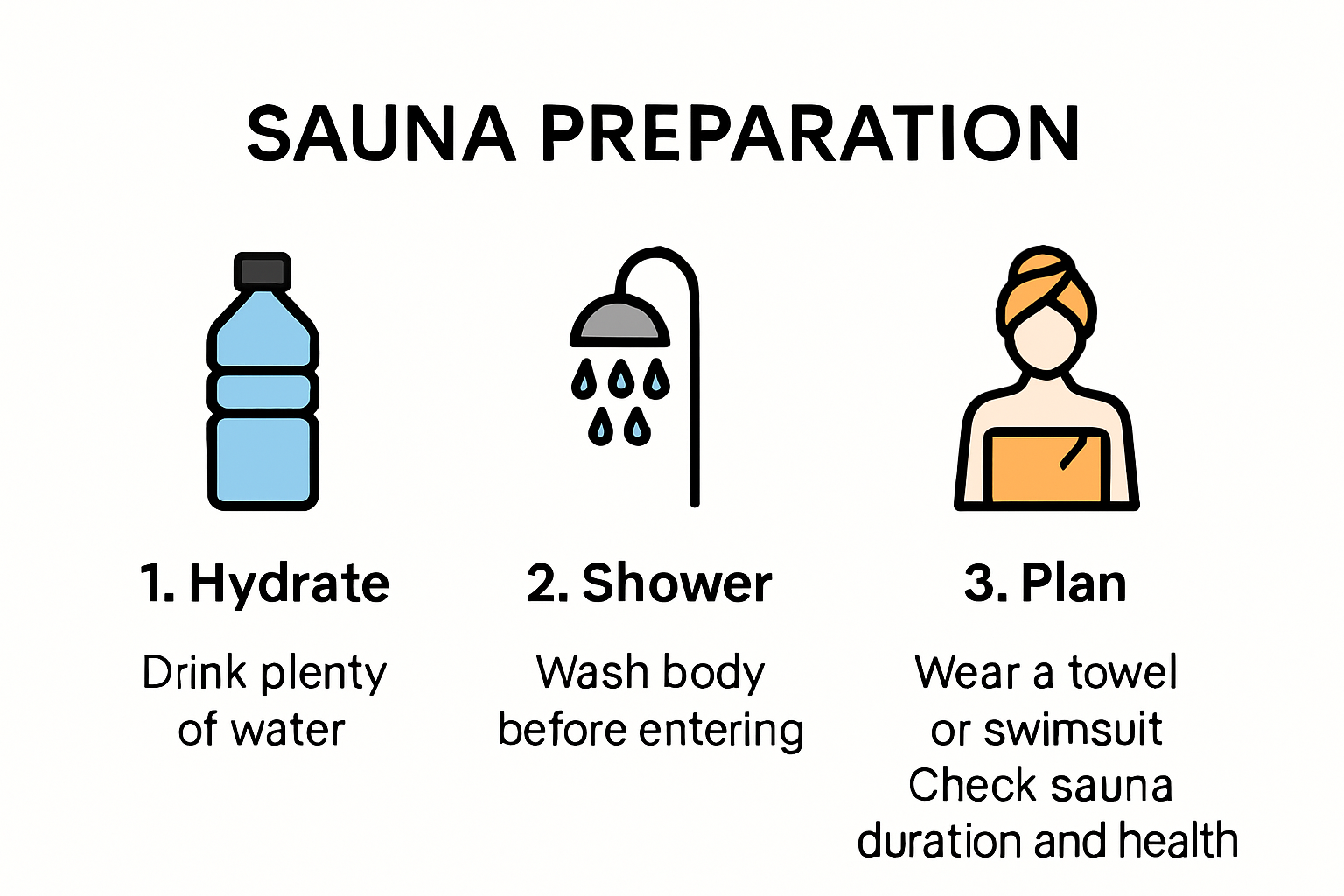
What to Do in a Sauna: Top Wellness Tips for 2025

Saunas promise a world of relaxation and renewal, but knowing what to actually do inside makes all the difference. Most people just sit and sweat, missing out on the real magic. The big surprise is that using the right breathing techniques in the sauna can actually lower anxiety and sharpen your mind, not just help you unwind. Get ready to discover simple rituals that turn every session into a complete wellness upgrade.
Table of Contents
- How To Prepare For A Sauna Session
- Essential Sauna Activities For Relaxation
- Maximizing Health Benefits While In The Sauna
- Sauna Safety And Aftercare Practices
Quick Summary
| Takeaway | Explanation |
|---|---|
| Hydration is essential | Drink 16 to 20 ounces of water two hours before your sauna session to prevent dehydration, and bring a water bottle to sip during the session. |
| Mental and physical preparation enhances experience | Take a warm shower before entering the sauna and approach the session with a relaxed mindset, wearing loose clothing or a towel. |
| Incorporate breathing and mindfulness techniques | Practice deep breathing methods like the 4-7-8 technique during your session to promote relaxation and mental clarity. |
| Consistent use maximizes health benefits | Aim for 2-3 sauna sessions per week, gradually increasing session times to enhance cardiovascular, muscle, and immune health. |
| Prioritize safety and aftercare | Consult a healthcare provider if you have pre-existing conditions, monitor your body’s response during sessions, and focus on proper cool-down and rehydration after use. |
How to Prepare for a Sauna Session
Maximizing your sauna experience requires thoughtful preparation. Proper preparation ensures you get the most health benefits while maintaining safety and comfort throughout your session.
Understanding Pre Sauna Hydration
Hydration is the cornerstone of a successful sauna experience. Your body will lose significant amounts of water through perspiration, making preparation critical. According to Harvard Health Publishing, drinking approximately 16 to 20 ounces of water two hours before your sauna session helps prevent dehydration. This proactive approach ensures your body is ready for the intense heat and sweating that will occur.
Beyond pre session hydration, experts recommend bringing a water bottle into the sauna. Small sips during your session can help maintain electrolyte balance and prevent overheating. Avoid consuming alcohol or caffeine before your sauna, as these substances can interfere with your body’s natural cooling mechanisms.

Preparing Your Body and Mind
Physical preparation goes beyond just drinking water. Thermory USA recommends taking a warm shower before entering the sauna. This practice serves multiple purposes: it cleanses your skin, opens your pores, and helps your body gradually adjust to increased temperatures. A pre sauna shower also helps remove any lotions, oils, or dirt that might interfere with your sweating process.
Mental preparation is equally important. Choose comfortable, loose fitting clothing or a towel to wear inside the sauna. Remove any jewelry that might become uncomfortably hot. Take a few deep breaths and approach your sauna session with a relaxed mindset. Understanding that your body will heat up and sweat profusely can help you remain calm and enjoy the experience.
Essential Pre Sauna Checklist
To further clarify the main steps for pre-sauna preparation, here is a checklist-style table that organizes the essentials for quick reference:
| Step | Action Needed | Notes |
|---|---|---|
| Hydration | Drink 16–20 oz of water before entering | Avoid alcohol/caffeine pre-session |
| Shower | Take a warm shower | Cleanses skin and opens pores |
| Clothing | Wear loose, comfortable attire or towel | Remove jewelry |
| Duration | Plan for 10–15 min initial sessions (beginners) | Gradually increase over time |
| Health Check | Consult healthcare provider if needed | Especially if you have pre-existing conditions |
Additionally, individuals with heart conditions, pregnant women, or those with certain medical restrictions should always consult their healthcare provider before starting sauna therapy. Your personal health history plays a crucial role in determining the safety and appropriateness of sauna use.
By following these preparation guidelines, you set yourself up for a safe, comfortable, and potentially therapeutic sauna experience. Remember that everyone’s body responds differently to heat, so listen to your body and adjust your approach accordingly.
Essential Sauna Activities for Relaxation
Transforming your sauna session from a simple heat experience into a profound wellness ritual requires intentional activities that promote deep relaxation and mental rejuvenation.
Breathing and Mindfulness Techniques
Breathing emerges as a powerful tool for relaxation during sauna sessions. Nosta Sauna recommends practicing deep, controlled breathing to enhance the therapeutic benefits of heat exposure. Slow, deliberate breaths help regulate your body’s stress response and create a meditative state.
Specifically, try the 4-7-8 breathing technique: inhale for four seconds, hold the breath for seven seconds, and exhale slowly for eight seconds. This method activates the parasympathetic nervous system, promoting profound relaxation. Practitioners report decreased anxiety and increased mental clarity during and after sauna sessions.
Meditation and Mental Wellness Practices
The sauna provides an ideal environment for mindfulness practices. According to Sauna Zeit, the enclosed, warm space naturally supports meditation by minimizing external distractions. Focus on body awareness, tracking sensations of heat, breath, and subtle muscular releases.
Consider guided meditation techniques tailored for sauna environments. Use visualization methods like imagining a peaceful landscape or focusing on gradual bodily relaxation. Some individuals find body scan meditations particularly effective, systematically releasing tension from toes to head while experiencing the sauna’s therapeutic warmth.
Therapeutic Movement and Stretching

Vail Health emphasizes that gentle movement can significantly enhance sauna relaxation. Subtle stretching helps muscles release tension and improves overall flexibility. Perform slow, controlled stretches that don’t elevate your heart rate excessively.
Recommended gentle movements include:
- Neck Rolls: Slowly rotate your head in circular motions
- Shoulder Shrugs: Raise and lower shoulders to release upper body tension
- Seated Twists: Gently rotate your torso while maintaining a comfortable seated position
- Ankle and Wrist Rotations: Improve circulation through subtle joint movements
To help you remember these relaxation techniques, here’s a summary table of recommended activities and their benefits in the sauna environment:
| Activity | How to Do It | Key Benefit |
|---|---|---|
| 4-7-8 Breathing | Inhale 4s, hold 7s, exhale 8s | Reduces anxiety, calms mind |
| Guided Visualization | Imagine peaceful scene, focus on senses | Promotes relaxation |
| Body Scan Meditation | Notice and relax each body part | Releases tension, increases awareness |
| Neck Rolls | Slowly rotate head in circles | Relieves neck/shoulder tension |
| Seated Twists | Gently twist torso left/right seated | Eases back and spine tension |
| Ankle/Wrist Rotations | Gently rotate joints while seated | Enhances circulation |
Remember to listen to your body. Movements should feel comfortable and never strain or cause discomfort. The goal is gentle release and relaxation, not intense exercise.
While these activities enhance your sauna experience, individual preferences vary. Experiment with different techniques to discover what resonates most with your personal relaxation style. The key is creating a peaceful, introspective environment that allows both body and mind to unwind completely.
Maximizing Health Benefits While in the Sauna
Sauna sessions offer more than just relaxation. Strategic approaches can transform your time in the sauna into a powerful wellness practice that supports multiple aspects of physical and mental health.
Cardiovascular and Neurological Wellness
Stanford Lifestyle Medicine reveals compelling research indicating that frequent sauna use can significantly reduce health risks. Specifically, individuals who use saunas four to seven times weekly demonstrate a remarkable 66% lower risk of developing dementia compared to those using saunas only once weekly.
The heat exposure triggers physiological responses similar to moderate cardiovascular exercise. Your heart rate increases, blood vessels dilate, and circulation improves. This process helps strengthen heart muscle, enhance blood flow, and potentially reduce risks associated with cardiovascular diseases. The controlled heat stress acts as a form of beneficial physiological conditioning, supporting long term heart health.
Pain Management and Musculoskeletal Support
Research from ScienceDirect demonstrates sauna bathing’s potential in managing chronic pain conditions. Studies indicate significant improvements for individuals suffering from musculoskeletal disorders, including osteoarthritis, rheumatoid arthritis, and fibromyalgia.
PubMed Central further supports these findings, noting that sauna sessions can alleviate pain and improve joint mobility in patients with rheumatic diseases. The heat promotes muscle relaxation, reduces inflammation, and increases flexibility. For individuals managing chronic pain, regular sauna use could represent a complementary approach to traditional pain management strategies.
Metabolic and Immune System Enhancement
Beyond pain relief, sauna sessions appear to positively influence metabolic processes and immune function. The heat stress induces a controlled inflammatory response, which may help strengthen immune system resilience. Sweating helps eliminate toxins, supports skin health, and can potentially boost metabolic rates.
Recommended strategies for maximizing health benefits include:
- Consistency: Aim for 2-3 sauna sessions per week
- Duration: Start with 10-15 minute sessions, gradually increasing to 20-30 minutes
- Hydration: Drink water before, during, and after your session
- Temperature: Maintain a comfortable heat level between 150-195 degrees Fahrenheit
- Cool Down: Allow your body to gradually return to normal temperature after each session
While sauna use offers numerous potential health benefits, individual experiences vary. People with pre existing health conditions should consult healthcare professionals before incorporating regular sauna sessions into their wellness routine. Pay attention to your body’s signals and adjust your approach accordingly to ensure a safe, beneficial experience.
Sauna Safety and Aftercare Practices
Sauna sessions offer incredible wellness benefits, but understanding and implementing proper safety protocols is crucial to ensuring a positive and healthy experience.
Medical Considerations and Risk Assessment
Harvard Health Publishing emphasizes that while saunas are generally safe, certain medical conditions require careful evaluation. Individuals with uncontrolled high blood pressure, heart disease, or specific cardiovascular issues should consult healthcare professionals before beginning sauna therapy.
PubMed Research specifically highlights contraindications for sauna use, including:
- Unstable angina pectoris
- Recent myocardial infarction
- Severe aortic stenosis
If you have pre existing health conditions, obtaining medical clearance is not just recommended but essential for your safety.
Safe Sauna Session Management
Proper sauna management involves strategic preparation and mindful practices. Harvard Health recommends several critical guidelines to minimize potential risks:
- Session Duration: Limit initial sessions to 15-20 minutes
- Hydration: Drink two to four glasses of cool water before and after
- Medication Awareness: Avoid medications that impair sweating
- Alcohol Restriction: Abstain from alcohol before and after sauna use
To organize safety measures and aftercare at a glance, the following table summarizes key sauna safety guidelines and their rationale:
| Safety Measure | Guideline/Action | Purpose |
|---|---|---|
| Session Duration | 15–20 minutes (initial sessions) | Prevent overheating |
| Hydration | 2–4 glasses cool water before/after | Avoid dehydration |
| Medication Awareness | Avoid meds impairing sweating | Ensure effective cooling |
| Alcohol Restriction | No alcohol before/after sauna | Reduce risk, maintain clear judgment |
| Listen to Body | Exit if dizziness/nausea/fatigue | Prevent serious health incidents |
| Medical Clearance | Obtain if existing health conditions | Ensure safe participation |
Additionally, pay attention to your body’s signals. If you experience dizziness, nausea, or excessive fatigue, exit the sauna immediately and cool down. Listening to your body is paramount in maintaining sauna safety.
Post Sauna Recovery and Aftercare
Recovery is as important as the sauna session itself. Implement a structured cool down process to help your body transition safely. Begin by sitting in a room temperature area, allowing your body to gradually return to its normal state. Avoid sudden temperature changes that might shock your system.
Rehydration becomes critical after sweating. Replace electrolytes by drinking water or consuming beverages with balanced mineral content. Some individuals find light stretching or gentle movement helpful during the cool down phase, promoting circulation and preventing muscle stiffness.
Wear loose, comfortable clothing post sauna and continue monitoring how you feel. If you experience prolonged weakness, headaches, or unusual symptoms, consult a healthcare professional. Remember that individual tolerance varies, and what works for one person might not be ideal for another.
By approaching sauna use with knowledge, respect for your body’s limits, and a commitment to safety, you can transform this wellness practice into a powerful tool for health and relaxation. Always prioritize your personal well being and make informed decisions based on your unique health profile.
Frequently Asked Questions
What should I do before entering a sauna?
To prepare for a sauna session, it’s essential to hydrate by drinking 16 to 20 ounces of water two hours before. Take a warm shower to cleanse your skin and open your pores. Wear loose clothing or a towel to ensure comfort.
How long should I stay in the sauna?
For beginners, it’s recommended to start with 10 to 15-minute sessions. As your body adjusts, you can gradually increase the duration to 20-30 minutes per session.
What are some activities I can do while in the sauna?
Focus on breathing and mindfulness techniques such as the 4-7-8 breathing method. You can also practice gentle stretching or meditation to enhance your relaxation experience.
How can I ensure my sauna experience is safe?
To ensure safety, limit your initial sauna sessions to 15-20 minutes, stay hydrated by drinking water before and after, avoid alcohol, and listen to your body. If you experience any dizziness or discomfort, exit immediately.
Elevate Your Sauna Ritual with Best Life Sauna
Feeling frustrated by lackluster results from typical sauna sessions? The article above explains how the right breathing techniques, personalized activities, and safety steps can turn your sauna time into a full wellness upgrade. Many people enter the sauna hoping for stress relief or improved circulation but leave without seeing real benefits. Do not let dehydration, poor preparation, or the wrong setup limit your progress. Genuine transformation starts with access to premium saunas and accessories that support your new rituals and maximize comfort.

If you are ready to enhance every session, explore the complete selection at Best Life Sauna. Discover everything from traditional to infrared saunas, plus must-have accessories and cold plunge tubs to complete your at-home sanctuary. Shop today for exclusive offers and free shipping on orders over $200. Visit https://bestlifesauna.com to bring the health benefits highlighted in the article directly to your home. Experience the difference now and make sauna wellness part of your daily routine.

